By Khalil Nouri Staff Writer–Editor
The United States is on a trajectory to lose the war in Afghanistan because its foreign policy has become entangled with President Hamid Karzai’s reprobate regime. Now, U.S. objectives are contingent upon Karzai’s willingness and ability to rid the endemic corruption within his administration, and – more importantly – within his own family. And despite intense pressure from the United States and the international community, Mr. Karzai still shows no appetite to rein in his half-brother Ahmed Wali Karzai, who is not only jeopardizing the entire tribal balance – this corrupt powerbroker is actually fueling the insurgency. We natives believe it is no longer an “Islamic fundamentalist war” but instead a “Pashtun civil war”, thus the upcoming offensive in the Pashtun-dominated southern city of Kandahar, the birthplace of the Taliban, will shape the final outcome of the war.
The average Kandahari is confused and disappointed with the twists and turns of U.S. strategy, specifically with regards to embracing and empowering Karzai’s crooked sibling, who has consolidated power and is now the “King” of Kandahar. Well-known as a drug trafficker, Wali Karzai controls a network that pushes over $3.5 billion worth of heroin each year, and controls politics at the regional and district levels.
“I think it’s in our best interest to figure out how to harness that leadership potential that Ahmed Wali Karzai has,” said Brig. Gen. Ben Hodges, the director of NATO operations in Southern Afghanistan. If the U.S. changes course and develops a more prudent strategy, there are still no guarantees. However, if the U.S. maintains the status quo the only things that can be guaranteed are that death on both sides and Afghans will never see peace.
Afghanistan is evidently on life support, with severe preexisting symptoms (constantly flaring-up) of ailments ranging from corruption, drug trafficking, and so forth (echoed repeatedly in the media) to recent swelling traumas of tribal feuds, instigated by Karzai family et al in Kandahar. This predicament is rattling all of Southern and Eastern Afghanistan and has doomed, or will cripple, the very foundation of tribal structure and nationalism in the country.
If there is no shift away from the paradigm of Muslim radicalism, certainly a re-emergence of the old bitter civil war between the two powerful Pashtun tribal groups—“Durranis” and “Ghelzais”—that was fought over three centuries ago, will explode upon us today.
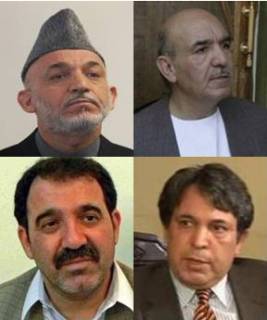
KANDAHAR’S POWER BROKERS
This is a complex indigenous phenomenon that requires a versatile perception that is beyond the comprehension of many in the West, and it is fueled and manipulated by the Karzai’s “Popalzai” clan of Durrani confederacy tribe, headed by Hamid Karzai’s half brother, Ahmad Wali Karzai, who is the head of the Kandahar provincial council and has assumed for himself the role of absolute monarch in this Southern Afghan city.
Also included in the mix are the Karzai family’s closest allies, who are more captivated with their own interests rather than a genuine partnership; but they have excluded all traditional elders in the smaller local communities from governance and planning—an alienation of key provincial constituencies. In addition, they have imposed lengthy technocratic strategies that are incomprehensible to local tribal leaders, which has alienated tribal communities and fuelled resentment that invites insurgents to infiltrate them and secure their allegiance against the state; the consequence is an imbalance of tribal structure that leads to a dire recipe for civil strife.
Furthermore, at the core level, the Karzai family (pictured above) has made an informal division of spheres such that; each Karzai brother has his own arena of influence. In fact, Hamid is the statesman, Mahmuod built a business empire, Qayum quietly manipulates things behind the scenes as the family’s “eminence grise”, and Ahmad Wali Karzai has proved adept at mastering local political dynamics and leveraging brother Karzai’s control as Head of State to slowly build his own power base in Kandahar. In a sublevel, however, the cousins, cronies and their limited tribal constituents (pictured below: left to right clockwise: Gul Agha Sherzai, Haji Jan Mohammad, Mattiullah and Arif Noorzai), claim their own portions of various government posts, including land ownership that took little to no real purchase power in exchange to obtain.
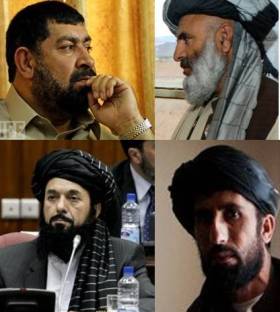
In addition, the family has benefited from using the institutions of the Afghan state to their advantage, and in doing so have formed important synergies linking politics in Kandahar and Kabul.
And as Ahamad Wali affirmed in one of his media interviews, “This is a country ruled by kings. The king’s brothers, cousins, sons are all powerful.” He further states, “This is Afghanistan. It will change but it will not change overnight.” This without a doubt shows how he flaunts himself as the ultimate ruler of the land in southern Afghanistan. He also describes himself as the “Nancy Pelosi of Kandahar,” portraying himself as a dealmaker capable of working with allies and rivals to stabilize Afghanistan.
Because of this “arrogance in plain sight”, other tribes in Kandahar are showing their deep displeasure and outright resentment (being deprived of living even a basic everyday life) towards NATO and the U.S., because of the empowerment that “foreigners” are given to the Karzai family and tribe. As a result, this constitutes the main ingredient for insurgency recruitment; and consequently the impending manifestation for a blowback beyond control.
Furthermore, paradoxically the assertion by U.S. officials, that they see Ahmad Wali Karzai, “as a polarizing figure who could complicate their efforts to win over the population”, makes no sense. This clearly sends a contradictory double message to the population, and many view this as a sign of U.S. weakness. How can you oppose him and back him up with military might at the same time?
A BRIEF INTRODUCTION OF PASHTUN TRIBAL STRUCTURE
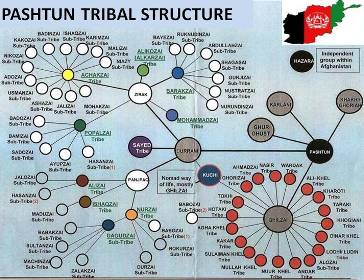
(Tribal names not visible in the chart, it is only to show the complexity of the system)
The multifaceted Pashtun tribes generally consist of multiple subdivisions, including sub-tribes and clans. In broad terms, on one side are the “Durranis” – most of the settled population of Kandahar are related to the Karzai “Popalzai” clan; they are the elite, the aristocrats, farmers, traders, and the professional middle class who have gained certain powers and prestige. On the other hand of the same body politics are the “Ghilzais”, who are traditionally nomadic, fiercely fundamentalist in religion, and whose tribal and village leaders were dependent on, and subordinate to, the local aristocracy—a class status that was less prominent in other Pashtun areas. Their homelands stretch east into Pakistan as far as Kashmir.
A RELENTLESS PASHTUN TRIBAL BLOWBACK IS ON THE HORIZON
Ever since Afghanistan emerged as a sovereign nation in 1709, when the “Ghilzais” defeated the Persians, its history has been etched in ancient hatreds between “Ghilzai” and “Durrani” groups. During most of that time, the country was ruled by the “Durrani” tribe, who in 1775 moved its capital from the “Ghilzai” stronghold of Kandahar to Kabul in the North. Nothing more fired up “Ghilzais’” enmity than the many occasions when the “Durranis” attempted to impose their rule from Kabul with the aid of “foreigners”; either “Tajiks” from the north or other outsiders such as the British, who invaded Afghanistan three times between 1838 and 1919 in a bid to secure the North-west Frontier of their Indian empire against the rebellious “Ghilzais.”
When the Soviets invaded Afghanistan in 1979, after years of “Durrani” rule, it was to support a revolutionary “Ghilzai” government. But this new foreign presence inspired general Afghan resistance, and was why (by the late 1980s) the U.S. was supporting the almost entirely “Ghilzai-run-Taliban”—then called Mujahideen—and their ally Osama Bin laden. In 1996 the “Taliban-Ghilzai” got their revenge, and imposed their theocratic rule over almost the whole country. In 2001, the West invaded Afghanistan to topple the Taliban, imposing “Durrani” rule again; now under “Durrani” President Karzai—however, he is from an unpopular “Popalzai” side of the “Durani” tribe.
Now, as so often before, the “Ghilzais” have seen their country hijacked by a “Durrani” regime, supported by a largely Tajik army backed by hated outsiders from the West. One reason why it is so hard for the West to win “hearts and minds” amongst the majority of Afghans is because the West is up against a sullenly resentful population, fired up by a timeless hatred and able to call upon unlimited support, in men and materiel, from their “Ghilzai” brethrens across the border in Pakistan. As aforementioned, the main reason for the overall resentment and growing insurgency to arrive is because the Karzai family and cronies are seen as an artificially imposed dominant tribal group in Kandahar (from the outset).
AN AFGHAN ARMY OF MINIMAL PASHTUNS
Another factor for a civil war in Afghanistan is the 65% Tajik recruitment in the Afghan National Army (ANA). There has been consistent reporting by Western media sources with the line that NATO troops operate “in support of” the ANA, and that, this genuine force reflects the whole nation. This misinformation campaign even released erroneous figures of the ethnic composition of the ANA. These artificial figures reflect the rule set up by the top brass in U.S. and NATO forces. Under this rule, the Afghan army should be 38 percent Pashtun, 25 percent Tajik, 19 percent Hazara and eight percent Uzbek. This would bring the numbers much closer to reflecting the nation’s ethnic composition.
A reliable source within the ANA—a close affiliate of Afghan Joint Chief of Staff General Bismillah Khan—has revealed, “The truth is that the ANA is now over 65% Tajik, and that figure is increasing.” He went on, “The Pashtun figure is hovering below 18% and may have been overtaken by the Uzbeks.”
In other words, the “Afghan National Army” is just the Northern Alliance with very expensive NATO provided gears and uniforms. Therefore, by sending the Northern Alliance supported by U.S. and NATO troops into core Pashtun tribal areas, all these forces are seen as alien occupiers. Locals vehemently resent this, and since they cannot identify with any of these forces, they are returning to the Taliban. This is further adding fuel to anger, leading to civil war.
HOW TO DEFUSE TRIBAL TENSION IN KANDAHAR
Since 1707 to December 2009 there were 19 grand assemblies of elders (Loya Jirgas) convened in Afghanistan, and mostly prior to 1880 the exact contents of discussions were never recorded due to the traditional nature of the process. However the results, discussions and decisions were all expressed orally from generation to generation.
Moreover, as I recall from my youth, my elders were in many political discussions about local tribal politics. They discussed Kandahar’s ancient tribal feud that required genuine thinking over a century ago, so essentially a Loya Jirga was convened. In that Tribal Jirga, a unanimous decision was made that “a ruling tribe cannot be in the majority.” Apparently the key idea was not to give prominence to a tribe whose supremacy and empowerment –just as now—could jeopardize the balance of the tribal structure.
Thus, one of the main reasons the “Mohammadzai” clan of “Barakzai” dynasty could rule Afghanistan for over a one-half century was because of its minor tribal constituency. The tribal balancing phenomenon has already been solved long ago, and history may need to repeat itself on this issue once again.
Contrary to the present, the old solution allowed tribal balance to be maintained for decades until 1979; and clearly within the Afghan tribal framework, a Jeffersonian style presidential election is doomed to failure.
A SUCCESSFUL LESSON FROM THE BRITISH
Another tale from two generations ago; when King Nadir Shah—from the “Durrani” tribe of “Mohammadzai” clan—was backed by the British to be the King in Afghanistan in 1929, he was supported mostly by the “Ghelzais” – largely by the “Waziri” and “Mashud” sub-tribes.
In order to keep the tribal balance between the two groups (the “Durranis” and “Ghelzais”) in check, he agreed to give the “Ghelzais” immunity in exchange of their achievements; conquering Kabul and subduing a rival named Habibullah Kalakani; this inaugurated Nader Shah’s reign. The immunity for the “Ghelzais” was noncompulsory participation in the Afghan military service, but in contrast, they were given higher ranks in brass appointments.
Conversely, if the King could be installed by his own “Durrani” tribe, the balance could also have been tipped by a “Ghelzais’” revolt. In hindsight, the old solution was a cautionary and well thought out plan for defusing any uprising.
SOME RECENT TRIBAL REPORTS FROM AFGHANISTAN
The tribal feud thus far is in upward swing; I recently received a telephone call from someone named Mr. Burhanuddin Kushkaki, who lives in Germany. He told me that 11 members of his family including close cousins in Eastern Afghanistan were among the dead due to a U.S. military night raid on their village of “Kushkak” in “Surkhrod” district of Nangarhar Province on May 14th 2010. Over the telephone, he played a 20 minutes long recorded tape of his cousin who immediately reported the incident from the scene. As I was hearing the man in the background explaining this dreadful situation, “This incident happened on the same night that Hamid Karzai was in Washington D.C. complaining about U.S. military raids on Afghan villages that caused loss of innocent lives.” He goes on, “we have done no harm to any one, and the provincial governor had no report of this incident.” Then he said, “This is a wrong intelligence report by someone who wanted to send a message to Karzai and Obama.” He then reiterated, “We are caught in a tribal feud and any able body will revengefully recruit and fight those who are killing us.” I later recalled a similar incident by the “Shinwari” tribe of “Mohmand” clan in early March 2010.
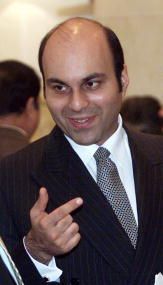
I also recently received another telephone call (on a different subject) from an acquaintance—Mr. Aman Gul Khan who is from the “Ghilzai” tribe of “Zazai” clan in Paktia province. He said, “I along with some tribal elders including the infamous “Haji Baydar Zazai” are working very hard to elevate the ex-King Zahir Shah’s grandson, Prince Mustapha Zahir.” He went further, “apparently nothing is working from Kandahar and we will do whatever we can to bring him in the same way we brought his great grandfather King Nader Shah to power.” This clearly is strong opposition to Kandahar’s current tribal imbalance situation that could rise to anarchy.
Some other tribal elders—Mawlawi Mateeula of Laghman, Haji Haider Ishaqzai of Helmand, Gen Noorzai of Farrah and many more—are suggesting a combined government of Amir Amanullah Khan and ex-King Zahir Shah’s siblings would definitely be supported by the majority in Afghanistan.
IN CONCLUSION — WHAT SHALL WE DO?
In a recent revealed Pentagon report; out of 121 districts critical to stabilizing Afghanistan, only 29 are sympathetic to the Afghan government. Forty-four are neutral and another 51 are sympathetic to the insurgency. Indeed, many people have ties—sometimes blood ties—to Taliban fighters. Obviously the almost decade old government of Hamid Karzai and the tribal imbalance wrought by Ahamad Wali Karzai are the main causes for the downward spiral into instability.
Evidently an old-fashioned military victory in Afghanistan is impossible. This is exactly the problem for the US; The Pentagon can’t let go. The military brass can’t admit that once again they can’t win a war. Clearly there is desperation in these efforts to secure something out of this mess.
Moreover, even if there were more evidence of United States success in Afghanistan, can anyone believe that the current Afghan leadership would be able to sustain whatever gains were made?
By the way, we are stuck with the notion that Karzai is the best partner available and Mr. Obama should not be looking for anyone else. As Fareed Zakaria says, “As a Pashtun and a major figure willing to ally with the U.S., Karzai is indispensable.” We natives believe the opposite; the international community is not looking hard enough for an acceptable head of state.
Pull out the troops, because this war can’t be won, but risk lots of blood in another civil war, and maybe a much worse and more dangerous scenario will emerge? Or shall we stay and take the risk of being trapped in a never-ending conflict, which will cost a huge amount of money, blood and tears?
What can we do? Let’s do the only thing we can do! Let’s have a Symposium of Afghans from around the world and do like my father’s generation, and the generations before him. Let’s seek out immediate, mid-range, and long range solutions for Afghanistan.
1) Let’s call for an immediate truce from all sides of this conflict.
2) Let’s seek mid-range economic solutions such as Biz-Jirgah to Biz-Jirgah, and Biomass to Energy. We can show how rubber dams can supply water for agricultural purposes and create hydropower energy for villages; but, these rubber dams must not be used to produce narcotics; any narcotics producers will lose their rubber dams to villages that obey international law; the Afghan Government should maintain these rubber dams. We will also offer software solutions for the two-year backlog of tax audits in Afghanistan. The Symposium will conclude with a Resolution Statement and an Action Plan.
3) Let’s seek long- range economic solutions by calling upon Afghans around the world to come together in one voice for peace through prosperity… and to change the current status that says that only 20% of Afghanistan’s national income comes from its people; the other 80% is coming from donor nations. This is unsustainable. We need to flip those numbers around… and to start an economic union of nations in South Asia with Afghanistan and Pakistan at its core. This economic union of nations can evolve into a multi-trillion dollar economy and bring peace and stability to the whole region.
Why fight over funds from other nations when we Afghans can build a bright future for and among ourselves. Just look around the globe and you will see very successful Afghan’s there. We know how to fight for what we believe in. The problem is that we have stopped believing in ourselves as a nation. Our best and brightest thinkers like Zalmay Khalilzad have not focus on what was best for Afghanistan, but instead, in my view, has favored the few over the many.
I have been very critical of Khalilzad lately as many others have been, and for good cause; but I would be the last person to say that he could never change. It is men like him that we desperately need, but with a different set of core values and principles.
To Zalmay Khalilzad and every other Afghan in the world; it is time we Afghan’s stop fighting among ourselves and put our ancestral homeland ahead of our differences. As we have learned from living in a democratic nation; we can have our differences; we can debate each other even in public, but when we are called to serve our ancestral homeland we must put those differences aside and work together for the good of all. That’s how serious I am about solutions for Afghanistan. I will exclude no one ahead of time (no one with blood on their hands) who is prepared to work on finding real solutions for Afghanistan.
Nelson Mandela was right in setting up a Truth Commission that allowed those who had wronged the people of South Africa to come forward, tell the painful truth, and be allowed to be reintegrated into society without retribution. Perhaps Afghanistan should go through this process sometime down the road. But first we have to stop the violence, bring peace, and put hope back into the minds of Afghans. I believe that once people can see, get a taste of, and believe in images of the future, they will move towards it, as John F. Kennedy knew so well.
Let’s do all this before there is a full blown civil war in Afghanistan!
Khalil Nouri is the cofounder of New World Strategies Coalition Inc., a native think tank for nonmilitary solution studies for Afghanistan. www.nwscinc.org
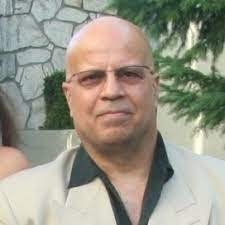
Khalil Nouri was born in an Afghan political family. His father, uncles, and cousins were all career diplomats in the Afghan government. His father was also amongst the very first in 1944 to open and work in the Afghan Embassy in Washington D.C., and subsequently his diplomatic career was in Moscow, Pakistan, London and Indonesia. Throughout all this time, since 1960’s, Khalil grew to be exposed in Afghan politics and foreign policy. During the past 35 years he has been closely following the dreadful situation in Afghanistan. His years of self- contemplation of complex Afghan political strife and also his recognized tribal roots gave him the upper edge to understand the exact symptoms of the grim situation in Afghanistan. In that regards, he sees himself being part of the solution for a stable and a prosperous Afghanistan, similar to the one he once knew. One of his major duties at the beginning of Operation Enduring Freedom in Afghanistan in 2002 was advisory role to LTG Franklin Hegenbeck. He has worked closely with the Afghan tribes and his tribal exposure is well tailored for unobstructed cross-cultural boundaries within all Afghan ethnicities. He takes pride in his family lineage specifically with the last name “Nouri” surnamed from his great-grandfather “Nour Mohammad Khan” uncle to King Nader-Shah and governor of Kandahar in 1830, who signed the British defeat and exit conformity leaving the last Afghan territory in second Anglo-Afghan war. Khalil is a guest columnist for Seattle Times, McClatchy News Tribune, Laguna Journal, Canada Free Press, Salem News, Opinion Maker and a staff writer for Veterans Today. He is the cofounder of NWSC Inc. (New World Strategies Coalition Inc.) a center for Integrative-Studies and a center for Integrative-Action that consists of 24- nonmilitary solution for Afghanistan. The function of the Integrative-Studies division (a native Afghan think tank) is to create ideas and then evolve them into concepts that can be turned over to the Integrative-Action division for implementation. Khalil has been a Boeing Engineer in Commercial Airplane Group since 1990, he moved to the United States in 1974. He has a Bachelor of Science degree in Mechanical Engineering, and currently enrolled in Masters of Science program in Diplomacy / Foreign Policy.
ATTENTION READERS
We See The World From All Sides and Want YOU To Be Fully InformedIn fact, intentional disinformation is a disgraceful scourge in media today. So to assuage any possible errant incorrect information posted herein, we strongly encourage you to seek corroboration from other non-VT sources before forming an educated opinion.
About VT - Policies & Disclosures - Comment Policy



